Artist Statement
2
Artist Statement
2
Artist Statement
2



LIN ZHU
LIN ZHU
LIN ZHU
My work is to explore the relationship between people and plants with plants as the carrier. In my life, there has always been the shadow of plants, such as the garden in my childhood memory home, I will collect plants mixed with books, as well as the education of Chinese culture from childhood and so on. I started to formally create plants in 2014, mainly focusing on painting. After coming to London, I subjectively began to have a variety of media attempts. I tried to make some new breakthroughs and attempts in materials, and I began to be more interested in using collage and sculpture to express this theme. In the first unit, I made some small collages and models about the garden. In my opinion, people can't leave the city, but they need a spiritual sustenance. The garden of the city becomes the habitat of the spirit.
I will be in unit 2, I will be specific to the relationship between people and plants in the indoor environment. The relationship between human beings and family plants is a relationship of dependence and care. Plants can arouse a kind of sympathy. In terms of materials, I chose cloth collage. As described by Magdalena Abakanowicz, a Polish Artist: "fabric is our covering and our attire. Made with our hands, it is a record of our souls.". This kind of temperature is also what I like to convey to the audience. People and plants are interdependent, and plants can comfort people's hearts.
My work is to explore the relationship between people and plants with plants as the carrier. In my life, there has always been the shadow of plants, such as the garden in my childhood memory home, I will collect plants mixed with books, as well as the education of Chinese culture from childhood and so on. I started to formally create plants in 2014, mainly focusing on painting. After coming to London, I subjectively began to have a variety of media attempts. I tried to make some new breakthroughs and attempts in materials, and I began to be more interested in using collage and sculpture to express this theme. In the first unit, I made some small collages and models about the garden. In my opinion, people can't leave the city, but they need a spiritual sustenance. The garden of the city becomes the habitat of the spirit.
I will be in unit 2, I will be specific to the relationship between people and plants in the indoor environment. The relationship between human beings and family plants is a relationship of dependence and care. Plants can arouse a kind of sympathy. In terms of materials, I chose cloth collage. As described by Magdalena Abakanowicz, a Polish Artist: "fabric is our covering and our attire. Made with our hands, it is a record of our souls.". This kind of temperature is also what I like to convey to the audience. People and plants are interdependent, and plants can comfort people's hearts.
My work is to explore the relationship between people and plants with plants as the carrier. In my life, there has always been the shadow of plants, such as the garden in my childhood memory home, I will collect plants mixed with books, as well as the education of Chinese culture from childhood and so on. I started to formally create plants in 2014, mainly focusing on painting. After coming to London, I subjectively began to have a variety of media attempts. I tried to make some new breakthroughs and attempts in materials, and I began to be more interested in using collage and sculpture to express this theme. In the first unit, I made some small collages and models about the garden. In my opinion, people can't leave the city, but they need a spiritual sustenance. The garden of the city becomes the habitat of the spirit.
I will be in unit 2, I will be specific to the relationship between people and plants in the indoor environment. The relationship between human beings and family plants is a relationship of dependence and care. Plants can arouse a kind of sympathy. In terms of materials, I chose cloth collage. As described by Magdalena Abakanowicz, a Polish Artist: "fabric is our covering and our attire. Made with our hands, it is a record of our souls.". This kind of temperature is also what I like to convey to the audience. People and plants are interdependent, and plants can comfort people's hearts.
Artist Statement
Artist Statement
Artist Statement
My work is to explore the relationship between people and plants with plants as the carrier. In my life, there has always been the shadow of plants, such as the garden in my childhood memory home, I will collect plants mixed with books, as well as the education of Chinese culture from childhood and so on. I started to formally create plants in 2014, mainly focusing on painting. After coming to London, I subjectively began to have a variety of media attempts. I tried to make some new breakthroughs and attempts in materials, and I began to be more interested in using collage and sculpture to express this theme. In the first unit, I made some small collages and models about the garden. In my opinion, people can't leave the city, but they need a spiritual sustenance. The garden of the city becomes the habitat of the spirit.
I will be in unit 2, I will be specific to the relationship between people and plants in the indoor environment. The relationship between human beings and family plants is a relationship of dependence and care. Plants can arouse a kind of sympathy. In terms of materials, I chose cloth collage. As described by Magdalena Abakanowicz, a Polish Artist: "fabric is our covering and our attire. Made with our hands, it is a record of our souls.". This kind of temperature is also what I like to convey to the audience. People and plants are interdependent, and plants can comfort people's hearts.
My work is to explore the relationship between people and plants with plants as the carrier. In my life, there has always been the shadow of plants, such as the garden in my childhood memory home, I will collect plants mixed with books, as well as the education of Chinese culture from childhood and so on. I started to formally create plants in 2014, mainly focusing on painting. After coming to London, I subjectively began to have a variety of media attempts. I tried to make some new breakthroughs and attempts in materials, and I began to be more interested in using collage and sculpture to express this theme. In the first unit, I made some small collages and models about the garden. In my opinion, people can't leave the city, but they need a spiritual sustenance. The garden of the city becomes the habitat of the spirit.
I will be in unit 2, I will be specific to the relationship between people and plants in the indoor environment. The relationship between human beings and family plants is a relationship of dependence and care. Plants can arouse a kind of sympathy. In terms of materials, I chose cloth collage. As described by Magdalena Abakanowicz, a Polish Artist: "fabric is our covering and our attire. Made with our hands, it is a record of our souls.". This kind of temperature is also what I like to convey to the audience. People and plants are interdependent, and plants can comfort people's hearts.
My work is to explore the relationship between people and plants with plants as the carrier. In my life, there has always been the shadow of plants, such as the garden in my childhood memory home, I will collect plants mixed with books, as well as the education of Chinese culture from childhood and so on. I started to formally create plants in 2014, mainly focusing on painting. After coming to London, I subjectively began to have a variety of media attempts. I tried to make some new breakthroughs and attempts in materials, and I began to be more interested in using collage and sculpture to express this theme. In the first unit, I made some small collages and models about the garden. In my opinion, people can't leave the city, but they need a spiritual sustenance. The garden of the city becomes the habitat of the spirit.
I will be in unit 2, I will be specific to the relationship between people and plants in the indoor environment. The relationship between human beings and family plants is a relationship of dependence and care. Plants can arouse a kind of sympathy. In terms of materials, I chose cloth collage. As described by Magdalena Abakanowicz, a Polish Artist: "fabric is our covering and our attire. Made with our hands, it is a record of our souls.". This kind of temperature is also what I like to convey to the audience. People and plants are interdependent, and plants can comfort people's hearts.
Education
·MA-Fine Arts: Painting,UAL : Camberwell College of Arts, UK
·MA-Oil Painting,Capital Normal University, China
·BA-Art&Design,Beijing University of Technology, China
work Experience
Art Teacher, Chen Jinglun Middle School, Beijing
exhibitions
Solo
Personal Exhibition of Zhu Lin`s Oil Painting, Joy City of Chaoyang , Beijing, China, 2017
“Colorful World” , Song Yang Art Gallery, Beijing, China, 2016
Zhu Lin photography exhibition, Beijing University of technology, Beijing, China, 2011
Group
“Distance to No. 2 Ganjiang West Road”: International Art Exhibition, Suzhou, China, 2019
“Back to The Perceptual” Cross-year Exhibition of Contemporary Art, Hangzhou, China, 2018
“Focus on China”: French Exhibition of Contemporary Artworks, France, Mar 2017
“Blooming space”: Invitational Exhibition, Ishikawa Gallery, Japan, 2017
Beijing Summer Exhibition 17, Enlai Art Gallery, Beijing, China, 2017
“Under the reality”: Young Joint Exhibition, Times Fangyuan Gallery, Beijing, China, 2017
“Hi Art” :New Art Fair, Liang Maqiao Residence, Beijing, China, 2017
Publication
Two Worlds: Diary of mobile phone photography, Jiangsu Phoenix Publisher, 2018
Awards
The Sixth Diary Painting of Chaoyang District, The First Prize, 2018
23rd National Calligraphy Painting Competition, The First Prize, 2018
Outstanding Student Scholarship at Beijing Capital Normal University, The First Class, 2015
Outstanding Student Scholarship at Beijing University of technology, The First Class, 2011
Education
·MA-Fine Arts: Painting,UAL : Camberwell College of Arts, UK
·MA-Oil Painting,Capital Normal University, China
·BA-Art&Design,Beijing University of Technology, China
work Experience
Art Teacher, Chen Jinglun Middle School, Beijing
exhibitions
Solo
Personal Exhibition of Zhu Lin`s Oil Painting, Joy City of Chaoyang , Beijing, China, 2017
“Colorful World” , Song Yang Art Gallery, Beijing, China, 2016
Zhu Lin photography exhibition, Beijing University of technology, Beijing, China, 2011
Group
“Distance to No. 2 Ganjiang West Road”: International Art Exhibition, Suzhou, China, 2019
“Back to The Perceptual” Cross-year Exhibition of Contemporary Art, Hangzhou, China, 2018
“Focus on China”: French Exhibition of Contemporary Artworks, France, Mar 2017
“Blooming space”: Invitational Exhibition, Ishikawa Gallery, Japan, 2017
Beijing Summer Exhibition 17, Enlai Art Gallery, Beijing, China, 2017
“Under the reality”: Young Joint Exhibition, Times Fangyuan Gallery, Beijing, China, 2017
“Hi Art” :New Art Fair, Liang Maqiao Residence, Beijing, China, 2017
Publication
Two Worlds: Diary of mobile phone photography, Jiangsu Phoenix Publisher, 2018
Awards
The Sixth Diary Painting of Chaoyang District, The First Prize, 2018
23rd National Calligraphy Painting Competition, The First Prize, 2018
Outstanding Student Scholarship at Beijing Capital Normal University, The First Class, 2015
Outstanding Student Scholarship at Beijing University of technology, The First Class, 2011
Education
·MA-Fine Arts: Painting,UAL : Camberwell College of Arts, UK
·MA-Oil Painting,Capital Normal University, China
·BA-Art&Design,Beijing University of Technology, China
work Experience
Art Teacher, Chen Jinglun Middle School, Beijing
exhibitions
Solo
Personal Exhibition of Zhu Lin`s Oil Painting, Joy City of Chaoyang , Beijing, China, 2017
“Colorful World” , Song Yang Art Gallery, Beijing, China, 2016
Zhu Lin photography exhibition, Beijing University of technology, Beijing, China, 2011
Group
“Distance to No. 2 Ganjiang West Road”: International Art Exhibition, Suzhou, China, 2019
“Back to The Perceptual” Cross-year Exhibition of Contemporary Art, Hangzhou, China, 2018
“Focus on China”: French Exhibition of Contemporary Artworks, France, Mar 2017
“Blooming space”: Invitational Exhibition, Ishikawa Gallery, Japan, 2017
Beijing Summer Exhibition 17, Enlai Art Gallery, Beijing, China, 2017
“Under the reality”: Young Joint Exhibition, Times Fangyuan Gallery, Beijing, China, 2017
“Hi Art” :New Art Fair, Liang Maqiao Residence, Beijing, China, 2017
Publication
Two Worlds: Diary of mobile phone photography, Jiangsu Phoenix Publisher, 2018
Awards
The Sixth Diary Painting of Chaoyang District, The First Prize, 2018
23rd National Calligraphy Painting Competition, The First Prize, 2018
Outstanding Student Scholarship at Beijing Capital Normal University, The First Class, 2015
Outstanding Student Scholarship at Beijing University of technology, The First Class, 2011
UNIT 2
Artists
UNIT 3
Miguel Chevalier
Miguel Chevalier, a French installation artist, was born on April 22th, 1959. He is mainly engaged in virtual art, using scientific calculation methods and various types of lighting to make decorative patterns that follow the changes of pedestrians. Among his many works, the series of "virtual garden" that makes me feel deeply impressed. His works present a supernatural artistic conception - a new generative and interactive garden. The work uses algorithms to create an artificial life universe with visual effects such as growth, diffusion and disappearance. Here, the lush virtual garden will bring tourists into the natural landscape interwoven with dreams and reality. Virtual plants appear randomly, bloom, and then fade, and repeat endlessly as the garden constantly updates and changes its own dynamics. When the audience interacts with the works through infrared sensors, the plants will tilt to the left or right.
I strongly feel the interactivity and modernity in his works. This virtual garden is full of imagination. In particular, the use of colorful lighting makes people in a wonderful world. Is this man-made nature also natural, or is it a variant nature? I think they are no longer natural, but dreams and illusions created by human will.
Sheila Hicks
Maryn Varbanov once wrote in his notes: "wool material is vital and exists organically in the human environment. It itself is a special natural expression. Our flesh has been placed in the woven space for so long. As long as you meditate, you will realize that from the tangible clothes to the invisible network We are not only facing the world of fiber, but also a part of fiber art. Sheila Hicks, an American artist, is one of the most important figures in the field of modern fiber art. She not only absorbed the weaving skills of ancient Peru, but also adopted the weaving methods of Indians. Starting from the study of traditional fabrics, and in the contemporary context of seeking breakthrough and innovation, she launched a profound reflection on the permanence of material and spirit contained in fabrics. She infuses colour into space, endows matter with full expression, and endows a work with various forms.
Her works have broken the traditional concept of organization. They are no longer flat. They can be three-dimensional and even public art. When I saw her work atterrissage, a huge flax thread fell from the sky, full of passion of red, yellow, blue and green, which strongly shocked my senses. This hanging exhibition makes me feel that her works are moving. In addition, some of her works are directly displayed outdoors. We can see the background behind the works and the dialogue between them. Her exhibition methods have inspired me a lot. I think I can learn more from her in the exhibition of my own works in the future.
Tamara Kostianovsky
Tamara kostianovsky, a fabric artist, is used to using cloth strips or discarded clothes as materials to create realistic elements of nature. In her latest series tree stumps, she uses the clothes of her father to make stumps with layers of different colors, which are used to remember the past time and express the concept that people will return to nature after passing away. "I am going to do something like this to commemorate my father's love of gardening and nature," she said. The purpose of using these costumes is to allow the father to appear in the sculpture so that he can be seen and not disappear.
This makes me feel that the combination of the whole theme and material is perfect. Because the clothing itself is a soft material, and Tamara combines her love for her father and compares her father's image to a tree, implying that people come from nature and return to nature. The whole thoughts is a meaningful process. Similarly, most of my works are made of cloth, among which I prefer clothes. Maybe it is because they are most connected to humans. Therefore, I also wanted to combine clothes with plants. Later, in my work plant sofa, I used old clothes to create strange plant images.
ÉlodieAntoine
The works of the Belgian artist Élodie Antoine caught my eye. She was good at creating flexible materials such as thread, wallpaper, wool carpet, daily necessities and hand washing basin, which broke the limitations of these items and gave them new meanings. What touched me most was that she had a lot of ideas for the display of her works. She tried to display her works from various manufacturers. Some are combined with daily life, and some are combined with the church. Even in an ordinary corner, she would paint patterns to echo the works.
Olafur Eliasson
In 2015, artist Olafur Eliasson and Danish geologist Minnick rohin transported 12 pieces of floating ice with a total weight of nearly 100 tons from Greenland. These ice blocks were then placed on the square in front of the Paris Pantheon, and placed in the shape of a clock and named it ice watch. As time goes on, these ice blocks begin to melt in the sun. In this process, the audience can intuitively experience the "climate warming", and let this global problem directly imprint on the people's hearts. In the future, they will be more sensitive to such issues. Surprisingly, unlike other works of art, these works of art, known as ice bells, have no fences and no security. They appear naked in the square or the open space in front of museums, welcoming the audience to touch and accelerate their melting. The ice turns into water on people's hands and clothes, and more of it flows down the ice to the ground, and then seeps into the ground. As they become smaller, the marks on the ground become heavier and heavier, people feel lost and never come back. Also aware of the "people" in the acceleration and promotion of the role, a sense of crisis arises.
I like his way to express his idea. It is neither story telling nor radical, but make you to thinking something comfortably. And many of his works use this way to appeal to people care for nature.




Sheila Hicks: Atterrissage, 2014 , Centre Pompidou, Paris
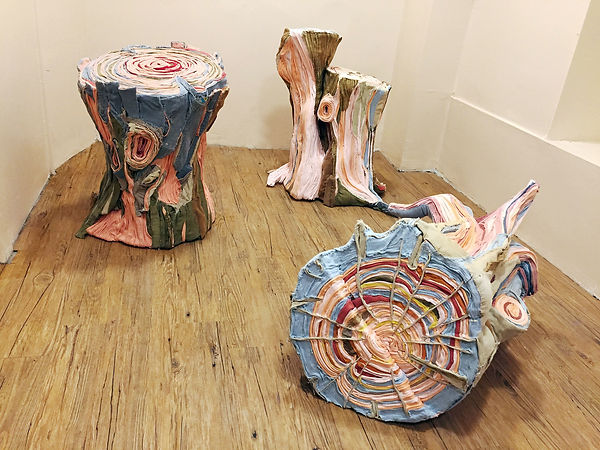


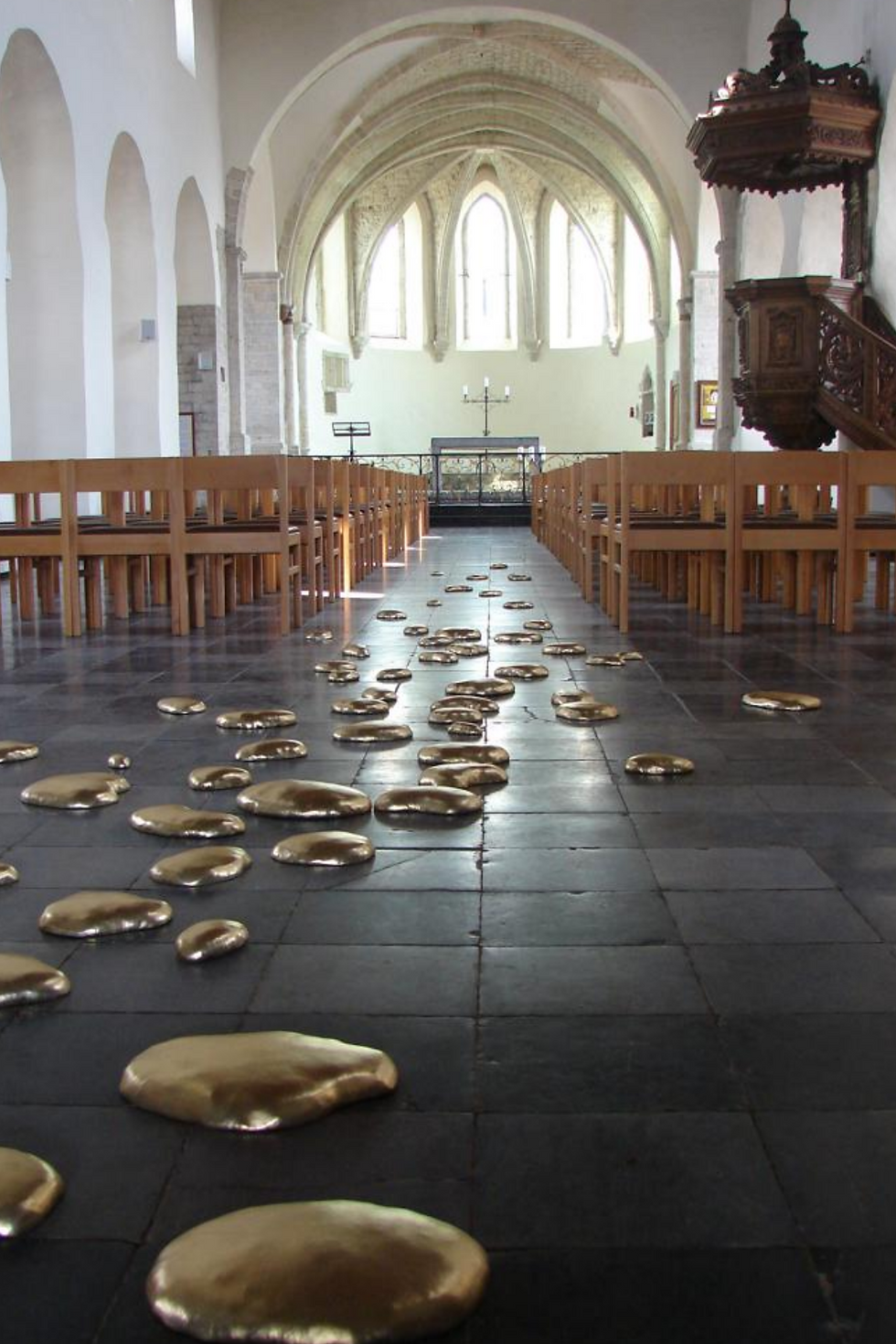


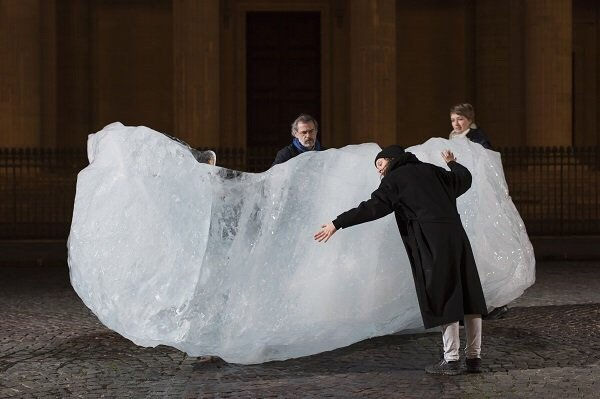
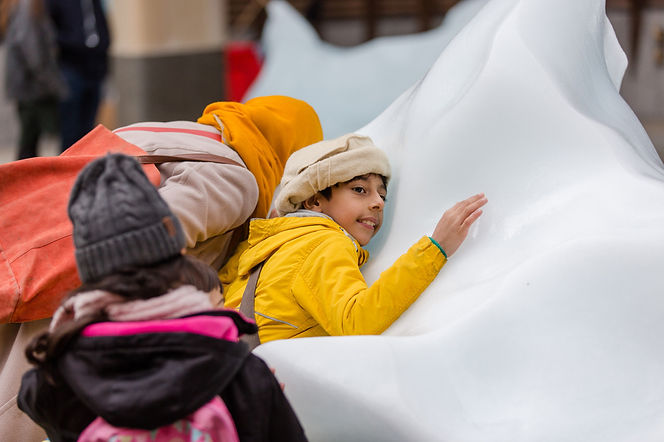
UNIT 2
I learned about Helen Barff in a group discussion. Later I found out that she was a graduate student of Camberwell in 2004. Her work form makes me feel very novel. Helen Barff works with found objects and materials such as felt, plaster, concrete, rubber or photographic surfaces, using processes such as wrapping, casting or other interventions in space and surface. She is interested in how materials are shaped by temporality, or how memory becomes embedded in matter. A sensitivity to touch is central to her practice.
Barff 's work is to transform the fleeting, ephemera or detritus, into weighty, corporeal forms, like bookends to the passage of time. This is what I am interested in because my works also use tangible materials to express abstract things. In her clothes and memory series, she thinks clothes also have memories. They encase us, wrap around us, give us physical edges. They help define our identity and our sense of self. When we move from elsewhere we pack our clothes, they give a continuity of self in a new space. Clothes contain memories and also contain us – in that way we inhabit our memories.
This idea reminds me of why not use clothes as a carrier to create my plants? Therefore, in unit 2, I began to try to use my old clothes to create.
Tau Lewis
Prolific Jamaican-Canadian Tau Lewis is a young and productive artist. Her works, which combined cast figural sculptures, found objects and plants, were arresting. Although her works mostly focus on black identity, they are not very close to my theme. However, there are many things worth learning. For example, some of her works also use plants, cacti.
Lewis says:"the cacti probably has the most symbolism in my work. I frequently use cacti to talk about diaspora and black identity. They are tropical plants that come from super-hot climates and they have been super-domesticated and they can survive anywhere in the world. And they also grow really prickly spines that act as preservation tactics".
In many plants, I also like to use cactus. They seem to have a strong sense of form, and cacti give people a lot of associations.
In addition, some of Tau Lewis's works are sewn and patched. She used a variety of materials to make collages, rags to make shapes, and photos to sew on the cloth. Some of her works also combine plaster and cloth, which gives me a lot of inspiration and shows me that in terms of material, I have a lot of directions to try.
Accidently, I saw a photo, like in the kitchen environment, everywhere are plants growing. Although plants can be seen everywhere in our space, and they are also a familiar kitchen, but the two elements are placed together in such an unusual way, which gives people an indescribable sense of drama. It may make us thinking some questions, why plants are here? what happened to them? Information about photographer Daniel Aires Grazina is rarely introduced online. However, his photography gives me some new ideas, changing the perspective of ordinary things, it will have new significance.
Brooklyn-based mixed-media artists Adam Frezza and Terri Chiao (occasionally aka CHIAOZZA) are all about the play; creating crafted joyful sculptures, installations, collages and paintings … I love how the duo has made it their mission to create fun, organic and connective objects. With a vibrant colour palette and a sense of the surreal, there is a sense of extraordinary to their work — inspired by the wild, the unknown, and colourful surfaces.
The couple of artists created a garden of plants with their hands. I was attracted by these strange and colorful plants. The images of these plants come from nature, but they are so interesting. They have an interesting idea that they believe everything imaginary is real, and everything real is imagined. Their work addresses this without trying to draw a distinction between the two. They carry the spirit of play through all their work, whether that medium is sculpture, painting, photography, drawing, printmaking … I really like their works, from their works I can feel that they enjoy the process of creation. That is what I have been looking for.
Some of their work is made of paper. I only have tried papers to collage a painting, but I have not used them to make some 3D work. When I saw their work I am eager to have a try and use brighter colours.
The artist Ethan Breckenridge places his plant subjects in undersized transparent prisms & cubes that emphasize the plant as a sympathetic creature. In his Too Soon installations in Bolivia (2009) & New York (2010), potted plants are crammed into carpeted cubes. The viewer empathizes with the plants, leaves pressed uncomfortably against the walls of the cube, & we may reflect upon our own domesticated & carpeted glass cubes. Breckinridge more specifically articulates the relationship between human & plant in Plants Have No Backs (2008)- another plant (or two in some iterations) in carpeted windowed structure- but this time furnished with a folding chair. The title & the presence of the chair immediately allow the viewer to compare herself to a plant, in particular those in front of her, humanoid in height. Without any need to sit down or rest its non-existent back, the chair remains empty. If a person were to sit in the chair, she would be in intimate conversation with the plant. One wall of the box is constructed out of a mirrored surface depicting infinite clones of plants with unoccupied chairs. The plant stands tall & unaffected, neither suffering nor lavishing its solitary existence.
Ethan Breckenridge's artistic expression makes it seem that people can talk with these plants. This allows me to contact my own creative works in terms of display effect. On the one hand, how to make the audience feel the same, on the other hand, how to let the audience participate in the works to think about the relationship between people and plants.
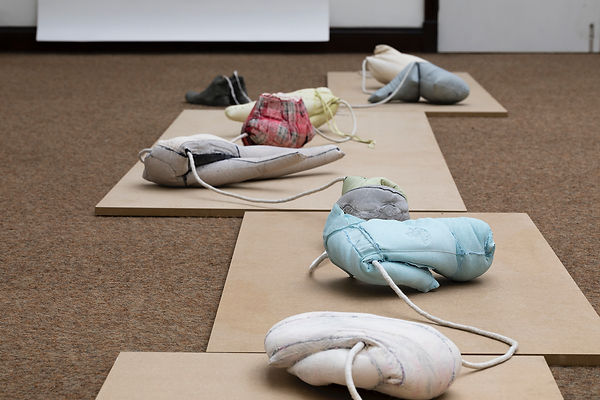%2C%20jesmonite%2C%20rope%2C%20c.jpg)

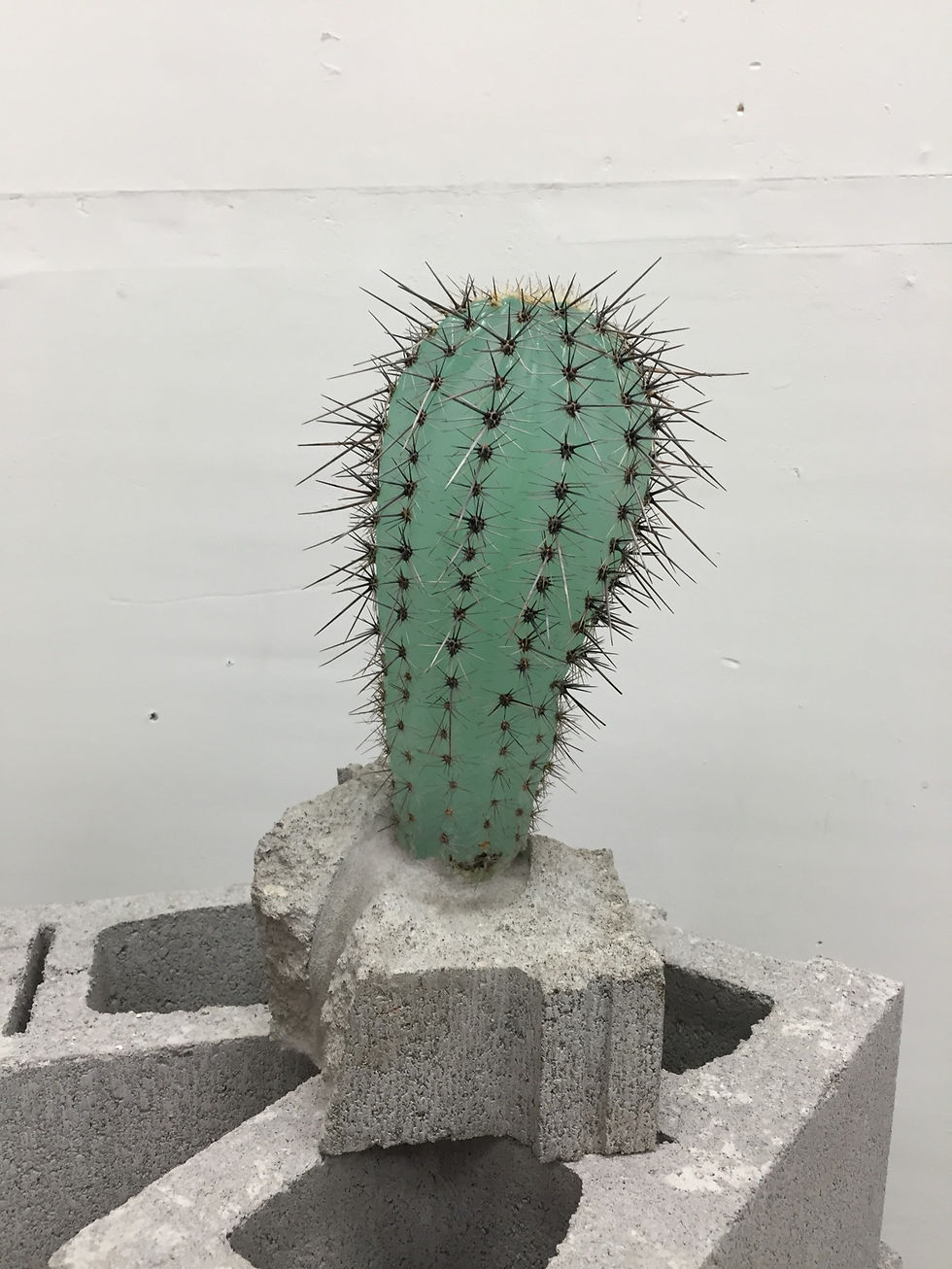


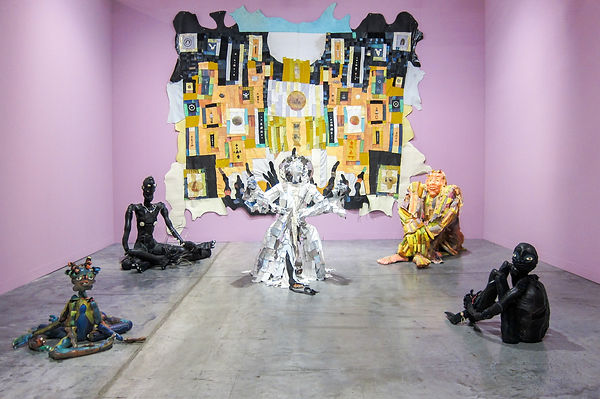




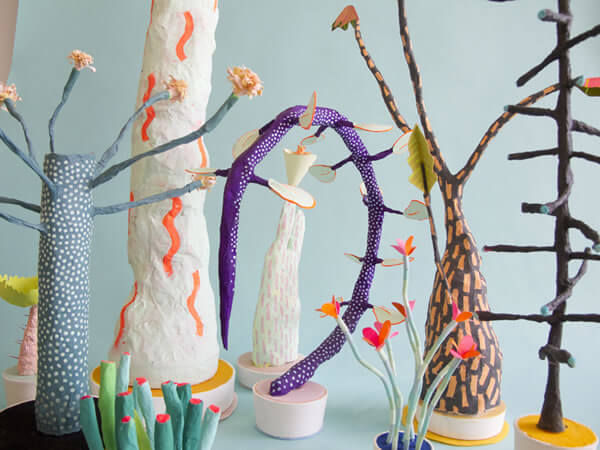

Max Ernst (1891- 1976)
A key member of first Dada and then Surrealism in Europe in the 1910s and 1920s, Max Ernst used a variety of mediums—painting, collage, printmaking, sculpture, and various unconventional drawing methods—to give visual form to both personal memory and collective myth. In the mid-1920s he developed the method of frottage, a form of rubbing with graphite that allowed him to collage together a variety of textures on one piece of paper. Later, working with the Spanish artist Joan Miró, Ernst experimented with grattage (scraping wet paint off a textured surface of a canvas to expose it in contrasts of color and value).
I am interesting his collage works which seems come from other world, I did some collage experiment and tried to make my works more unreal and absurd. I love the playful effect. Cut out a section through a newspaper or magazine and reassemble it to create a ridiculous effect.
UNIT 1


The Haas Brothers
The Haas Brothers, twins Nikolai and Simon (b. 1984), had a creative upbringing in Austin, Texas where their opera singer mother, actor brother and sculptor father taught them to play music, write, sing and paint. I saw their work at the Frieze London. In their current works, The Haas Brothers explore aesthetic and formal themes related to nature, science fiction, sexuality, psychedelia and color theory in prolific materials. Their mastery and uniquely clever use of materials ranging from brass, bronze, porcelain and fur to highly technical resins and polyurethane, matched with their insatiable curiosity and remarkable visual intelligence. And I was interested in their material and think that how do they make the ceramic so amazing? I have tied clay before, and I want to continue use this medium in the later creation. I noticed that they used some special pigments to make the porcelain look natural. In addition, the shape of each work is very special.

The Haas Brothers' work in Frieze
Karl Blossfeldt (1865 – 1932)
"My flowers should be good for people's recovery and restoration of their relationship with nature. They should awaken the meaning of nature, show their rich forms, remind those who watch them - people should for their own sake, fall down, and carefully observe the plant world around them. " Said Karl Blossfeldt
The reason why I like his works is that his work make me feel peaceful. He used his own camera and self-made lens to magnify the details of plants by 30 times, and made detailed observation and shooting. He showed unprecedented texture by amplifying the simple form on the film. The plants he took are like human's portraits.


Fred Tomaselli
"Art is really about perception, and mine have been changed through present other realities."
Fred Tomselli is a contemporary American painter, acclaimed for his collage works incorporating unconventional materials and depicting surreal scenes. His resin-coated photographic on wood panel feature layers of patterns, often alongside illcit substances such as pills-prescription and otherwise- hallucinogenic plants and herbs. I noticed that he used the resin material, which made the surface of the painting smooth and shiny. Then draw on it to enrich the level of the picture. This material makes the collage more decorative.
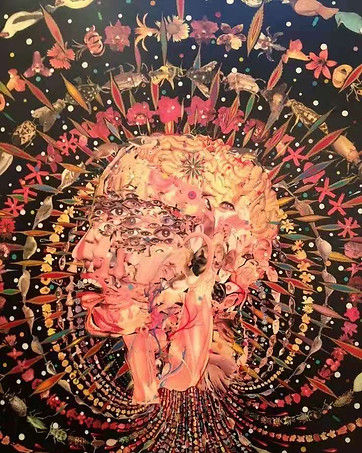
Fred Tomselli's creative process
Anya Gallaccio
Anya Gallaccio (b. 1963, Scotland; lives and works in London and San Diego, CA) creates site-specific installations, often using organic materials as her medium. Due to the nature of these materials, her works undergo natural processes of transformation and decay, often with unpredictable results. I think one of her most influenced work is called preserving beauty. She puts flowers on a wall, and the observer sees the process of flowers from fresh blooming to decaying through the glass Observers use their olfactory and visual experience devices. They will experience the smell of fresh flowers when they are fresh, or the smell of rotten when they are rotten. I reckon it is a kind of recording the time by using real plants. It makes thinking why can I not use the plants as the material directly. Sometimes plants themselves can convey something.



Joana Vasconcelos
http://www.artnet.com/artists/joana-vasconcelos/
When I saw Joana Vasconcelos's work for the first time, I am totally fascinated with it. Joana Vasconcelos creates sculptures, frequently on a very large scale, from familiar, domestic objects. They reference art, popular culture, and national identity and cleverly combined mass-produced items with elements of handicraft such as crochet or knitting. Yet they are also meticulously and ingeniously engineered. They can be witty, colourful, engaging and provocative.I'm also trying to make sculptures with soft materials, and it's very enlightening to see her works. She collages a piece of work with a variety of fabrics, and most of her works are spectacular. In addition, her works are bright in color, giving people a bright feeling in front of their eyes. Her works make me want to enlarge my plant series, and also can take some collage effect.

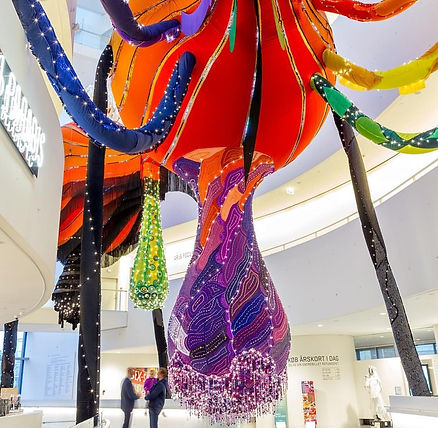

Garden of Eden, 2007
Garden of Eden is an ambitious work that explores the relationship between art, nature, and technology and ponders on our perception of nature in the future. Artificial flowers containing fiber optics sourced from China pulse with changing lights and we hear the dim sound of hundreds of motors, driving the whole of the installation. Joana's garden contains no scent and operates independently of weather conditions, meteorology or seasons of the year. This garden is the product of urban, industrialized society. Electricity and mass production are vital to its creation.
Each of the sets of flowers is contained within an individual container which offers flexibility in terms of layout. Interestingly, Joana has chosen to create the kind of patterns associated with the Serpentine style of 18th century gardening, found at several stately homes throughout Britain. Probably the most noted proponent of this style was Lancelot “Capability" Brown. The serpentine patterns are often said to be related to the curves of the female body and therefore to notions of beauty. It seems that man's attempts to manipulate and control the natural landscape are nothing new!
Visitors can wander through this completely artificial and multi-sensory indoor garden which contains a certain beauty yet is also sightly chilling. " The Garden of Eden" is the place where, according to Christian teaching, Adam and Eve succumbed to temptation and committed the original sin, resulting in their expulsion from Paradise. On the one hand, it seems like a timely reminder of the ways in which man is destroying our natural resources and changing the environment of wonder and excitement about what might be achieved through man's relationship with technology in the future.
Joana Vasconcelos is an artist who continues to create grandiose works that are elegant, intelligent, original and beautifully crafted. They are aesthetically magnificent and retain a wit and vibrancy that will hopefully engage visitors on a variety of levels, both now and for generations to come.

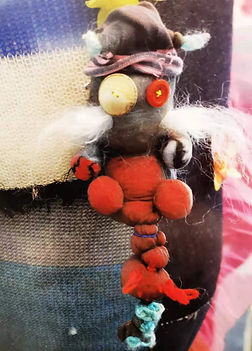

Excess Valkyrie, 2005
Valquiria Excesso (Excess Valkyrie) (2005) is probably the most elaborate and exuberant of a series of works referencing the Valkyries. A riot of colours and textures, this strange, semi-organic looking being suspends from the ceiling and occupies a good proportion of the gallery space. These works reference specifically female creatures from Norse mythology whose functions were both domestic and heroic. They are created from a combination of found and newly produced materials and combine knitting, crochet, appliqué and found objects. The work beautifully celebrates Joana's achievements as an artist but also the achievements of the many (mostly women) who have created objects and garments for the home. Such handicrafts might vary throughout the world in terms of colour, techniques, customs and traditions but essentially, they are an international phenomenon with which we can all associate.
As the Valkyrie travels, she collects souvenirs from the places she has visited. Whilst installing the work at the gallery, Joana became interested in two small dolls our Assistant Education Curator Keiko Higashi had made as demonstration pieces for practical workshops.These dolls were pinned onto Excess Valkrie and will now become an integral part of her.